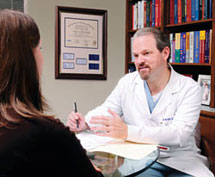New Life After Cancer
By Josh Till
 |
Advanced procedures now available at UAB can help women and men preserve or restore their ability to start a family after cancer treatment, says G. Wright Bates Jr., director of UAB's Division of Reproductive Endocrinology and Infertility. |
When patients are diagnosed with cancer, they suddenly face a lot of questions about a lot of issues—treatment options, insurance concerns, sick time from work, and many others. But there is one question many patients often don’t think about: Will cancer affect my ability to have children?
For some, the answer is yes. The number of individuals facing cancer during their reproductive years is significant—about 800,000 men and women. Depending on the type of cancer and the treatments involved, the chances for survivors to conceive after treatment can be low.
But UAB’s Reproductive Endocrinology and Infertility Services Clinic is working to increase those chances. The clinic offers patients several options to preserve or restore their fertility to start a family after they complete their cancer treatment.
“Today UAB offers several advanced procedures for preserving fertility, especially for women,” says G. Wright Bates Jr., M.D., director of the Division of Reproductive Endocrinology and Infertility. “We want to raise awareness among men and women going through chemotherapy and radiation about their options and encourage discussion of reproductive issues with their oncologist.”
A Family of Options
For men, there is really only one option, Bates says. And it’s a fairly simple one: banking sperm by freezing the semen before beginning chemotherapy or radiation treatment. Most of the male patients who come to UAB’s clinic suffer from testicular cancer or lymphoma, and once frozen, the sperm remain viable indefinitely.
Women have more fertility options, though they are not as simple. UAB offers patients these solutions:
- In vitro fertilization (IVF) and embryo freezing: This method combines fertility medication with retrieval of the eggs prior to chemotherapy or radiation. The eggs are then fertilized through IVF, and the embryos are frozen for later use. While this is the most established and successful option, it does require precise timing, expense, and the availability of sperm. The fertility injections necessary for IVF also can elevate estrogen levels, which can be dangerous for women with estrogen-sensitive tumors, such as some types of breast cancer.
- IVF and egg freezing: This option is available for women who may not have a partner. The eggs are harvested and frozen without being fertilized in the hopes of later using them for IVF. This technique is still considered to be experimental.
- Ovarian tissue freezing: Another experimental option, this treatment involves the retrieval of ovarian tissue for women who want a solution that does not include the time and hormone treatments required for IVF. The tissue is frozen and stored for reimplantation in the ovary after cancer treatment is complete, thus restoring normal hormone production.
“As far as we know, frozen eggs, embryos, and ovarian tissue are good indefinitely,” Bates says. “Our biggest limitation for the success of achieving pregnancy is the age of the woman.”
While a man produces sperm throughout his life, a woman is born with all the eggs she will ever have. At mid-gestation, a female fetus has between six and eight million eggs. By birth, that number is down to less than a million, and by puberty, only about 600,000 are left. Dozens to hundreds of eggs can be lost during each monthly menstrual cycle, and by menopause a woman may have only around 1,000 eggs remaining.
“It is very difficult for women in their 40s to achieve a successful pregnancy regardless of the type of treatment used,” Bates says. “We are very limited by age, regardless of health or cancer history.” Consequently, UAB does not routinely offer IVF for women who have reached their 43rd birthdays.
Awareness and Answers
UAB now is involved in several initiatives to increase awareness of fertility preservation and cancer. One of these is Fertile Hope, a national nonprofit organization dedicated to providing reproductive information, support, and hope to cancer patients and survivors who are at risk of infertility due to their treatments.
UAB also is one of the first institutions to join the Oncofertility Consortium, a nationwide group of researchers and clinicians exploring new and improved methods for fertility preservation in cancer patients. One of the group’s goals is to better communicate fertility preservation options to patients at the time of diagnosis, before treatment begins.
“While we do a better job addressing reproductive issues at UAB than nationally, there is still a great deal of education needed,” Bates says. “Less than 10 percent of men are offered sperm banking, and fewer than 1 percent of women are offered referral to a fertility doctor. It’s also been shown that women who discussed fertility preservation are able to more successfully cope with their disease and treatment.”
Bates adds that while fertility preservation options may not work for everyone, just knowing that they exist is a key first step. “Although many of these methods are experimental, our ability to preserve or restore fertility is progressing rapidly so patients don’t have to wait decades for this technology,” he says. “These are options available now, and even more successful options are coming in the near future. Our clinic strives to do what is best for the patient on every level—mentally, emotionally, physically, ethically, and financially. If a patient has a desire to start or continue a family in the future, now is the time to talk about it.”
This article originally appeared in Crossroads, the magazine of the UAB Comprehensive Cancer Center.